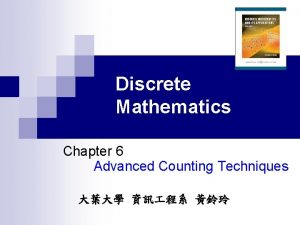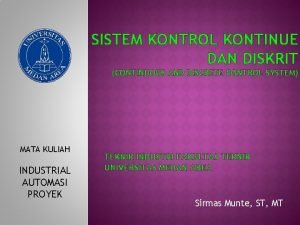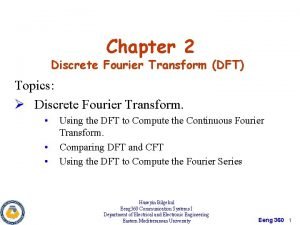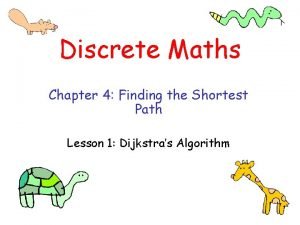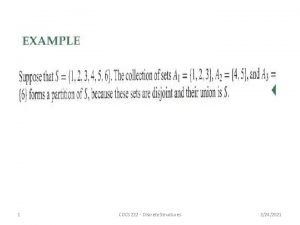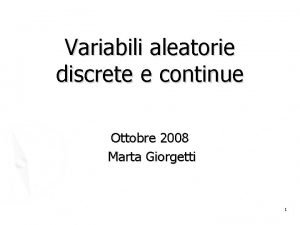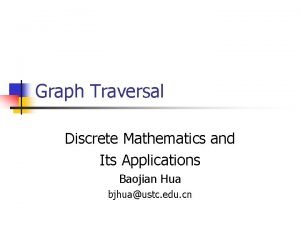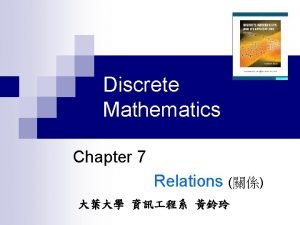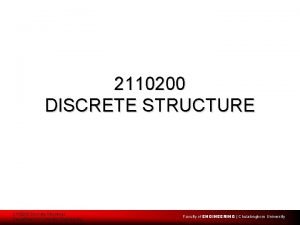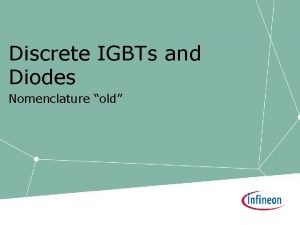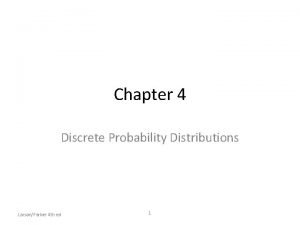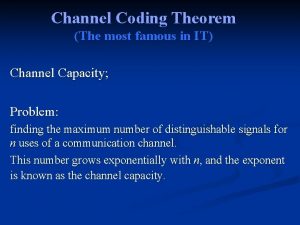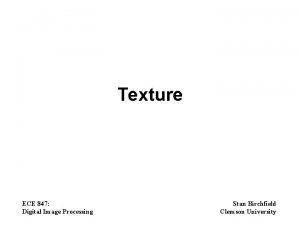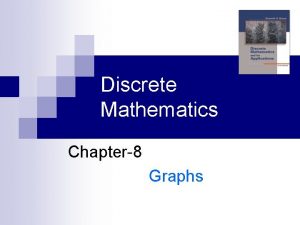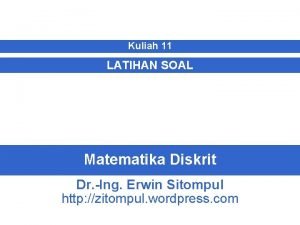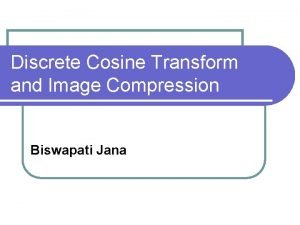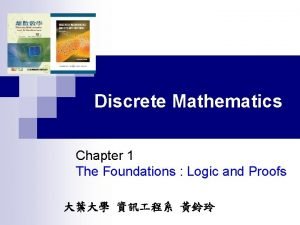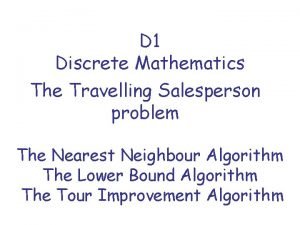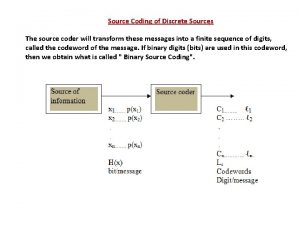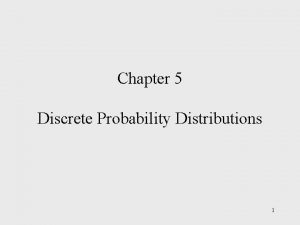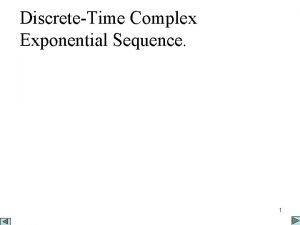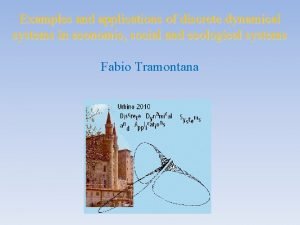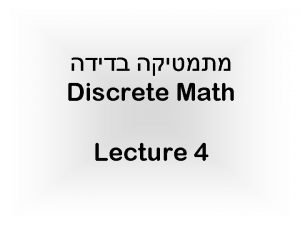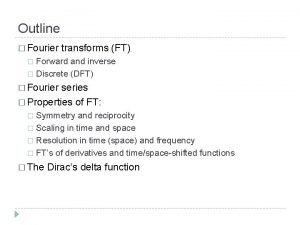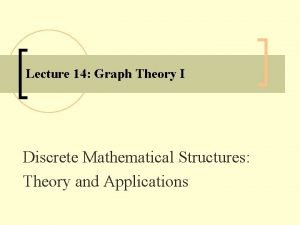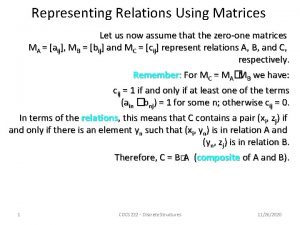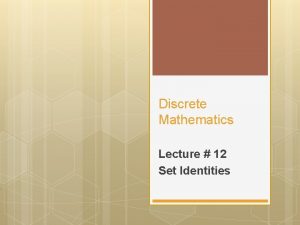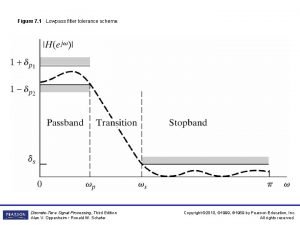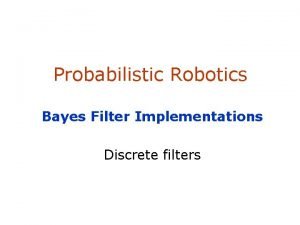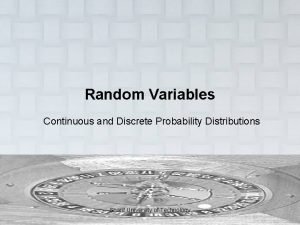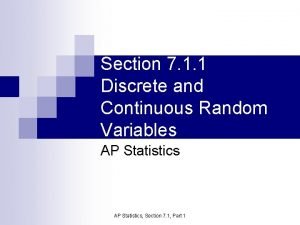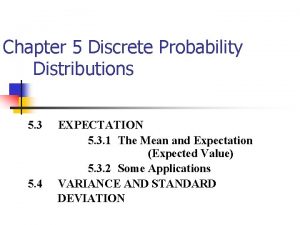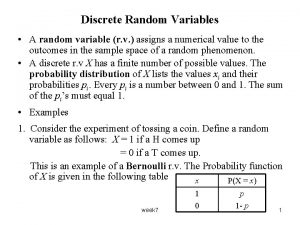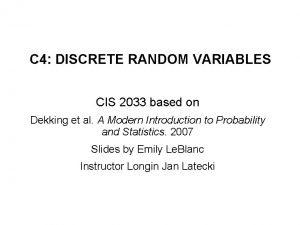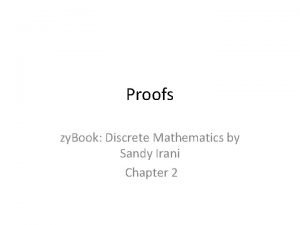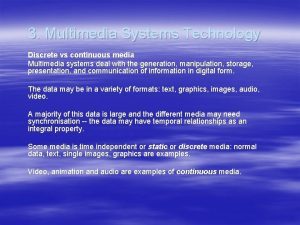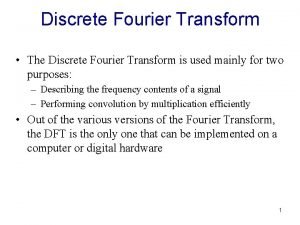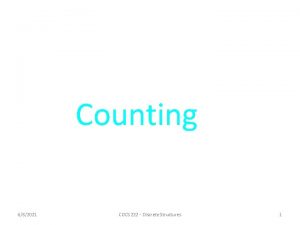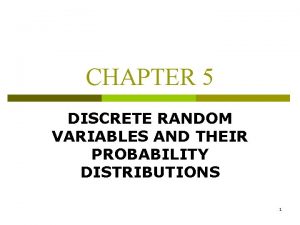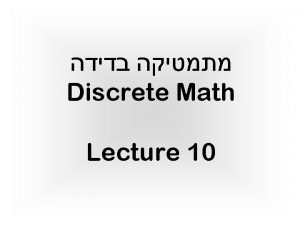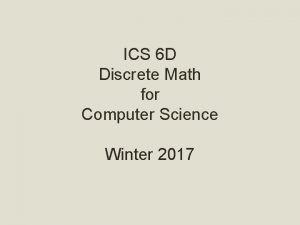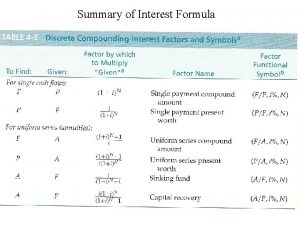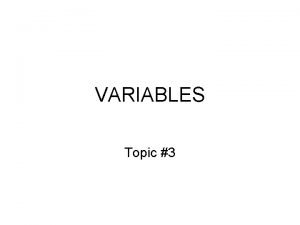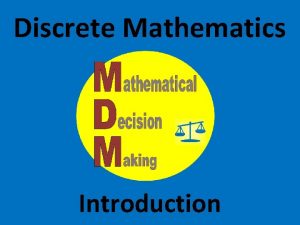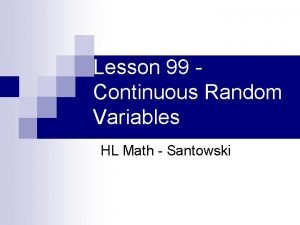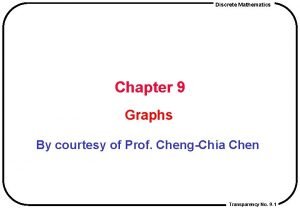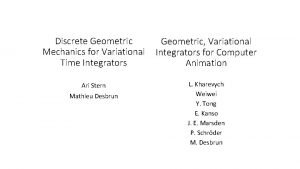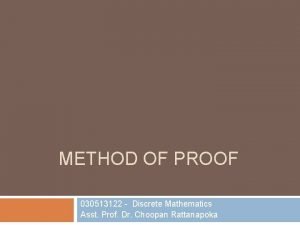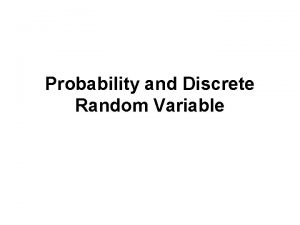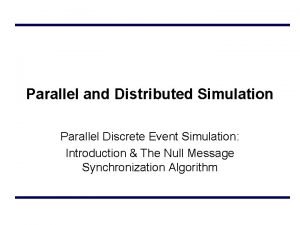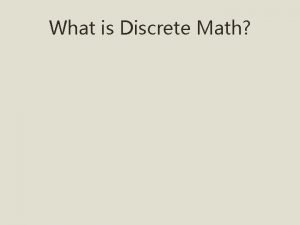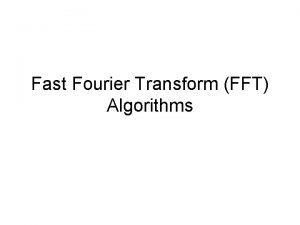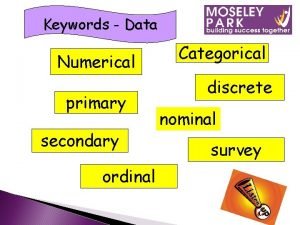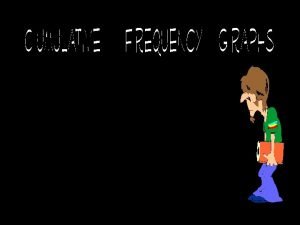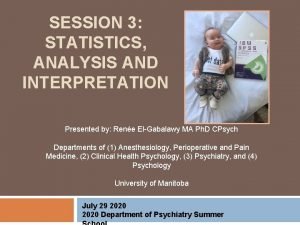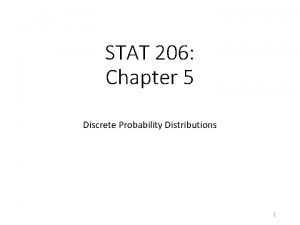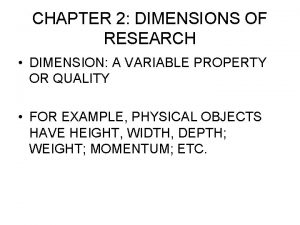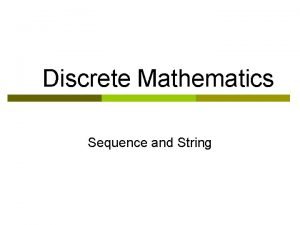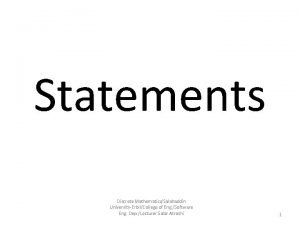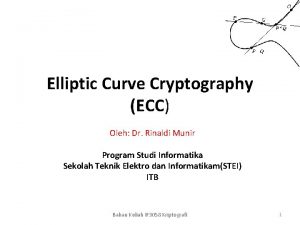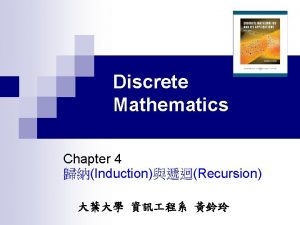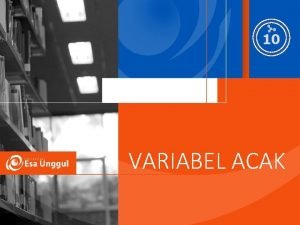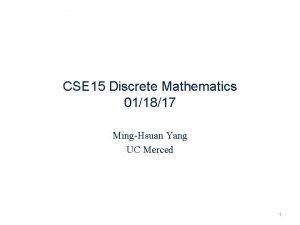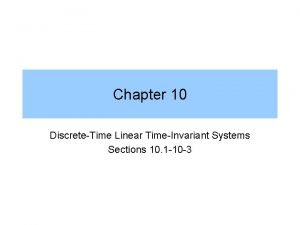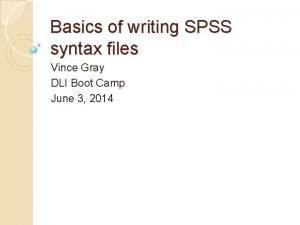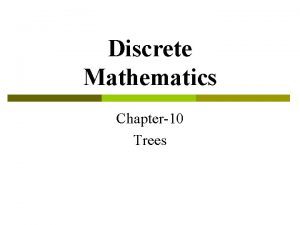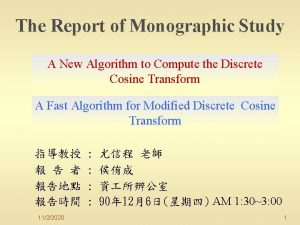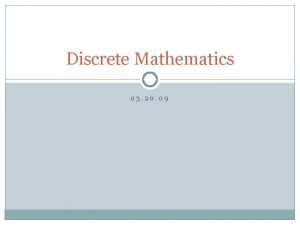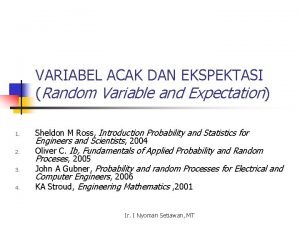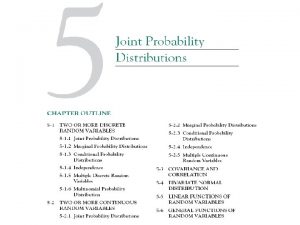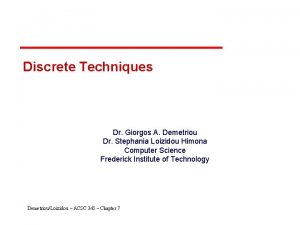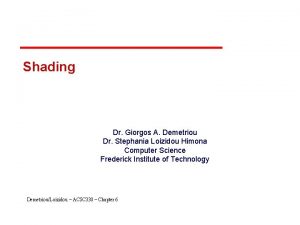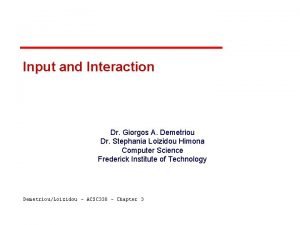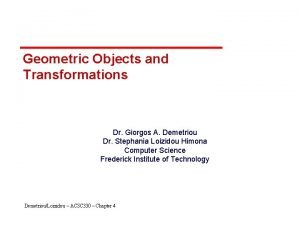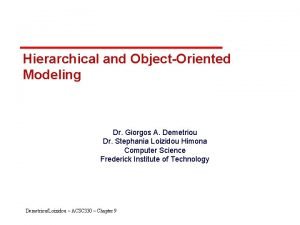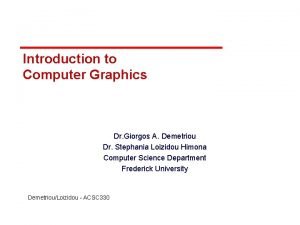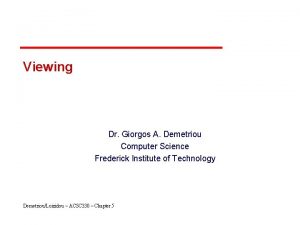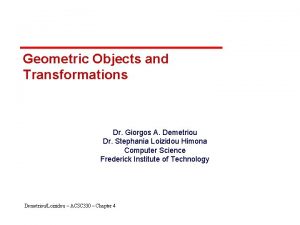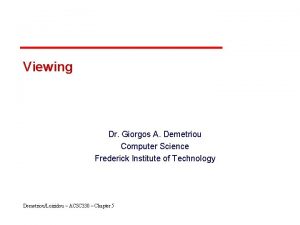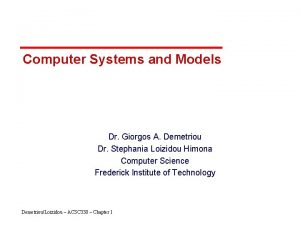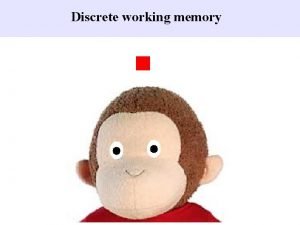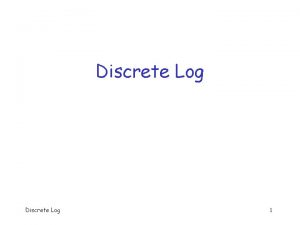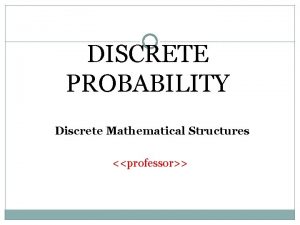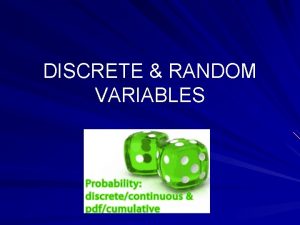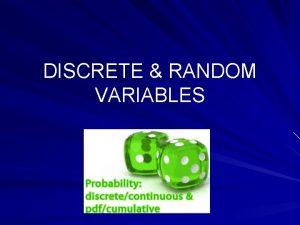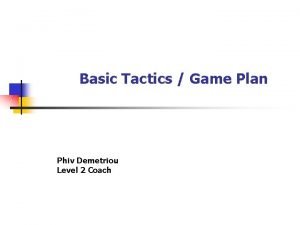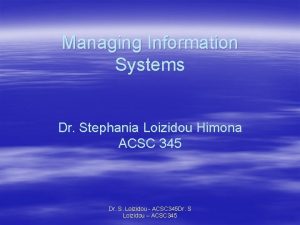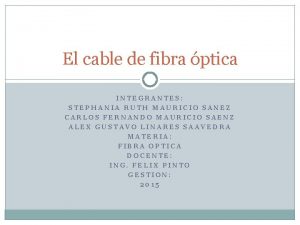Discrete Techniques Dr Giorgos A Demetriou Dr Stephania














![Example: Checker Board GLubyte wb[2] = {0 x 00, 0 x ff}; GLubyte check[512]; Example: Checker Board GLubyte wb[2] = {0 x 00, 0 x ff}; GLubyte check[512];](https://slidetodoc.com/presentation_image_h2/f25a28c4806c9f3f6353861fbb0ff9ce/image-15.jpg)




![Reading the Header FILE *fd; int k, nm; char c; int i; char b[100]; Reading the Header FILE *fd; int k, nm; char c; int i; char b[100];](https://slidetodoc.com/presentation_image_h2/f25a28c4806c9f3f6353861fbb0ff9ce/image-20.jpg)
![Reading the Header (cont) fscanf(fd, "%c", &c); while(c == '#') { fscanf(fd, "%[^n] ", Reading the Header (cont) fscanf(fd, "%c", &c); while(c == '#') { fscanf(fd, "%[^n] ",](https://slidetodoc.com/presentation_image_h2/f25a28c4806c9f3f6353861fbb0ff9ce/image-21.jpg)









































![Generating Texture Coordinates § Open. GL can generate texture coordinates automatically gl. Tex. Gen{ifd}[v]() Generating Texture Coordinates § Open. GL can generate texture coordinates automatically gl. Tex. Gen{ifd}[v]()](https://slidetodoc.com/presentation_image_h2/f25a28c4806c9f3f6353861fbb0ff9ce/image-63.jpg)





















![Open. GL Fog Functions GLfloat fcolor[4] = {……}: gl. Enable(GL_FOG); gl. Fogf(GL_FOG_MODE, GL_EXP); gl. Open. GL Fog Functions GLfloat fcolor[4] = {……}: gl. Enable(GL_FOG); gl. Fogf(GL_FOG_MODE, GL_EXP); gl.](https://slidetodoc.com/presentation_image_h2/f25a28c4806c9f3f6353861fbb0ff9ce/image-85.jpg)






- Slides: 91

Discrete Techniques Dr. Giorgos A. Demetriou Dr. Stephania Loizidou Himona Computer Science Frederick Institute of Technology Demetriou/Loizidou – ACSC 345 – Chapter 7

Buffer Define a buffer by its spatial resolution (n x m) and its depth k, the number of bits/pixel Demetriou/Loizidou – ACSC 345 – Chapter 7 2

Open. GL Frame Buffer Demetriou/Loizidou – ACSC 345 – Chapter 7 3

Open. GL Buffers § Color buffers can be displayed § § Front Back Auxiliary Overlay § Depth § Accumulation § High resolution buffer § Stencil § Holds masks Demetriou/Loizidou – ACSC 345 – Chapter 7 4

Writing in Buffers § Conceptually, we can consider all of memory as a large twodimensional array of pixels § We read and write rectangular block of pixels § Bit block transfer (bitblt) operations § The frame buffer is part of this memory source writing into frame buffer (destination) Demetriou/Loizidou – ACSC 345 – Chapter 7 5

Writing Model Read destination pixel before writing source Demetriou/Loizidou – ACSC 345 – Chapter 7 Demetriou - Computer Graphics - Chapter 7 6

Writing Modes § Source and destination bits are combined bitwise § 16 possible functions (one per column in table) replace XOR OR Demetriou/Loizidou – ACSC 345 – Chapter 7 7

XOR mode § Recall from Chapter 3 that we can use XOR by enabling logic operations and selecting the XOR write mode § XOR is especially useful for swapping blocks of memory such as menus that are stored off screen If S represents screen and M represents a menu the sequence S S M M S S M swaps the S and M Demetriou/Loizidou – ACSC 345 – Chapter 7 8

The Pixel Pipeline § Open. GL has a separate pipeline for pixels § Writing pixels involves § Moving pixels from processor memory to the frame buffer § Format conversions § Mapping, Lookups, Tests § Reading pixels § Format conversion Demetriou/Loizidou – ACSC 345 – Chapter 7 9

Raster Position § Open. GL maintains a raster position as part of the state § Set by gl. Raster. Pos*() § gl. Raster. Pos 3 f(x, y, z); § The raster position is a geometric entity § Passes through geometric pipeline § Eventually yields a 2 D position in screen coordinates § This position in the frame buffer is where the next raster primitive is drawn Demetriou/Loizidou – ACSC 345 – Chapter 7 10

Buffer Selection § Open. GL can draw into or read from any of the color buffers (front, back, auxiliary) § Default to the back buffer § Change with gl. Draw. Buffer and gl. Read. Buffer § Note that format of the pixels in the frame buffer is different from that of processor memory and these two types of memory reside in different places § Need packing and unpacking § Drawing and reading can be slow Demetriou/Loizidou – ACSC 345 – Chapter 7 11

Bitmaps § Open. GL treats 1 -bit pixels (bitmaps) differently than multi-bit pixels (pixelmaps) § Bitmaps are masks which determine if the corresponding pixel in the frame buffer is drawn with the present raster color § 0 color unchanged § 1 color changed based on writing mode § Bitmaps are useful for raster text § GLUT_BIT_MAP_8_BY_13 Demetriou/Loizidou – ACSC 345 – Chapter 7 12

Raster Color § Same as drawing color set by gl. Color*() § Fixed by last call to gl. Raster. Pos*() gl. Color 3 f(1. 0, 0. 0); gl. Raster. Pos 3 f(x, y, z); gl. Color 3 f(0. 0, 1. 0); gl. Bitmap(……. gl. Begin(GL_LINES); gl. Vertex 3 f(…. . ) § Geometry drawn in blue § Ones in bitmap use a drawing color of red Demetriou/Loizidou – ACSC 345 – Chapter 7 13

Drawing Bitmaps gl. Bitmap(width, height, x 0, y 0, xi, yi, bitmap) offset from raster position increments in raster position after bitmap drawn first raster position second raster position Demetriou/Loizidou – ACSC 345 – Chapter 7 14
![Example Checker Board GLubyte wb2 0 x 00 0 x ff GLubyte check512 Example: Checker Board GLubyte wb[2] = {0 x 00, 0 x ff}; GLubyte check[512];](https://slidetodoc.com/presentation_image_h2/f25a28c4806c9f3f6353861fbb0ff9ce/image-15.jpg)
Example: Checker Board GLubyte wb[2] = {0 x 00, 0 x ff}; GLubyte check[512]; int i, j; for(j=0; i<64; i++) for (j=0; j<64, j++) check[i*8+] = wb[(i/8+j)%2]; gl. Bitmap( 64, 0. 0, check); Demetriou/Loizidou – ACSC 345 – Chapter 7 15

Pixel Maps § Open. GL works with rectangular arrays of pixels called pixel maps or images § Pixels are in one byte ( 8 bit) chunks § Luminance (gray scale) images 1 byte/pixel § RGB 3 bytes/pixel § Three functions § Draw pixels: processor memory to frame buffer § Read pixels: frame buffer to processor memory § Copy pixels: frame buffer to frame buffer Demetriou/Loizidou – ACSC 345 – Chapter 7 16

Open. GL Pixel Functions gl. Read. Pixels(x, y, width, height, format, type, myimage) start pixel in frame buffer size type of pixels pointer to processor type of image memory GLubyte myimage[512][3]; gl. Read. Pixels(0, 0, 512, GL_RGB, GL_UNSIGNED_BYTE, myimage); gl. Draw. Pixels(width, height, format, type, myimage) starts at raster position Demetriou/Loizidou – ACSC 345 – Chapter 7 17

Image Formats § We often work with images in a standard format (JPEG, TIFF, GIF) § How do we read/write such images with Open. GL? § No support in Open. GL § Open. GL knows nothing of image formats § Some code available on Web § Can write readers/writers for some simple formats in Open. GL Demetriou/Loizidou – ACSC 345 – Chapter 7 18

Displaying a PPM Image § PPM is a very simple format § Each image file consists of a header followed by all the pixel data § Header P 3 # comment 1 # comment 2. #comment n rows columns maxvalue pixels Demetriou/Loizidou – ACSC 345 – Chapter 7 19
![Reading the Header FILE fd int k nm char c int i char b100 Reading the Header FILE *fd; int k, nm; char c; int i; char b[100];](https://slidetodoc.com/presentation_image_h2/f25a28c4806c9f3f6353861fbb0ff9ce/image-20.jpg)
Reading the Header FILE *fd; int k, nm; char c; int i; char b[100]; check for “P 3” float s; int red, green, blue; in first line printf("enter file namen"); scanf("%s", b); fd = fopen(b, "r"); fscanf(fd, "%[^n] ", b); if(b[0]!='P'|| b[1] != '3'){ printf("%s is not a PPM file!n", b); exit(0); } printf("%s is a PPM filen", b); Demetriou/Loizidou – ACSC 345 – Chapter 7 20
![Reading the Header cont fscanffd c c whilec fscanffd n Reading the Header (cont) fscanf(fd, "%c", &c); while(c == '#') { fscanf(fd, "%[^n] ",](https://slidetodoc.com/presentation_image_h2/f25a28c4806c9f3f6353861fbb0ff9ce/image-21.jpg)
Reading the Header (cont) fscanf(fd, "%c", &c); while(c == '#') { fscanf(fd, "%[^n] ", b); printf("%sn", b); fscanf(fd, "%c", &c); } ungetc(c, fd); skip over comments by looking for # in first column Demetriou/Loizidou – ACSC 345 – Chapter 7 21

Reading the Data fscanf(fd, "%d %d %d", &n, &m, &k); printf("%d rows %d columns max value= %dn", n, m, k); nm = n*m; image=malloc(3*sizeof(GLuint)*nm); s=255. /k; scale factor for(i=0; i<nm; i++) { fscanf(fd, "%d %d %d", &red, &green, &blue ); image[3*nm-3*i-3]=red; image[3*nm-3*i-2]=green; image[3*nm-3*i-1]=blue; } Demetriou/Loizidou – ACSC 345 – Chapter 7 22

Scaling the Image Data We can scale the image in the pipeline gl. Pixel. Transferf(GL_RED_SCALE, s); gl. Pixel. Transferf(GL_GREEN_SCALE, s); gl. Pixel. Transferf(GL_BLUE_SCALE, s); We may have to swap bytes when we go from processor memory to the frame buffer depending on the processor. If so we need can use gl. Pixel. Storei(GL_UNPACK_SWAP_BYTES, GL_TRUE); Demetriou/Loizidou – ACSC 345 – Chapter 7 23

The display callback void display() { gl. Clear(GL_COLOR_BUFFER_BIT); gl. Raster. Pos 2 i(0, 0); gl. Draw. Pixels(n, m, GL_RGB, GL_UNSIGNED_INT, image); gl. Flush(); } Demetriou/Loizidou – ACSC 345 – Chapter 7 24

The Limits of Geometric Modeling § Although graphics cards can render over 10 million polygons per second, that number is insufficient for many phenomena § § Clouds Grass Terrain Skin Demetriou/Loizidou – ACSC 345 – Chapter 7 25

Modeling an Orange § Consider the problem of modeling an orange (the fruit) § Start with an orange-colored sphere § Too simple § Replace sphere with a more complex shape § Does not capture surface characteristics (small dimples) § Takes too many polygons to model all the dimples Demetriou/Loizidou – ACSC 345 – Chapter 7 26

Modeling an Orange (cont. ) § Take a picture of a real orange, scan it, and “paste” onto simple geometric model § This process is texture mapping § Still might not be sufficient because resulting surface will be smooth § Need to change local shape § Bump mapping Demetriou/Loizidou – ACSC 345 – Chapter 7 27

Three Types of Mapping § Texture Mapping § Uses images to fill inside of polygons § Environmental (reflection mapping) § Uses a picture of the environment for texture maps § Allows simulation of highly specular surfaces § Bump mapping § Emulates altering normal vectors during the rendering process Demetriou/Loizidou – ACSC 345 – Chapter 7 28

Texture Mapping geometric model texture mapped Demetriou/Loizidou – ACSC 345 – Chapter 7 29

Environment Mapping Demetriou/Loizidou – ACSC 345 – Chapter 7 30

Bump Mapping Demetriou/Loizidou – ACSC 345 – Chapter 7 31

Where does mapping take place? § Mapping techniques are implemented at the end of the rendering pipeline § Very efficient because few polygons pass down the geometric pipeline Demetriou/Loizidou – ACSC 345 – Chapter 7 32

Is it simple? § Although the idea is simple---map an image to a surface---there are 3 or 4 coordinate systems involved 2 D image 3 D surface Demetriou/Loizidou – ACSC 345 – Chapter 7 33

Coordinate Systems § Parametric coordinates § May be used to model curved surfaces § Texture coordinates § Used to identify points in the image to be mapped § World Coordinates § Conceptually, where the mapping takes place § Screen Coordinates § Where the final image is really produced Demetriou/Loizidou – ACSC 345 – Chapter 7 34

Texture Mapping parametric coordinates texture coordinates world coordinates screen coordinates Demetriou/Loizidou – ACSC 345 – Chapter 7 35

Mapping Functions § Basic problem is how to find the maps § Consider mapping from texture coordinates to a point a surface § Appear to need three functions x = x(s, t) y = y(s, t) z = z(s, t) § But we really want to go the other way (x, y, z) t s Demetriou/Loizidou – ACSC 345 – Chapter 7 36

Backward Mapping § We really want to go backwards § Given a pixel, we want to know to which point on an object it corresponds § Given a point on an object, we want to know to which point in the texture it corresponds § Need a map of the form s = s(x, y, z) t = t(x, y, z) § Such functions are difficult to find in general Demetriou/Loizidou – ACSC 345 – Chapter 7 37

Two-part mapping § One solution to the mapping problem is to first map the texture to a simple intermediate surface § Example: map to cylinder Demetriou/Loizidou – ACSC 345 – Chapter 7 38

Cylindrical Mapping parametric cylinder x = r cos 2 p u y = r sin 2 pu z = v/h maps rectangle in u, v space to cylinder of radius r and height h in world coordinates s=u t=v maps from texture space Demetriou/Loizidou – ACSC 345 – Chapter 7 39

Spherical Map § We can use a parametric sphere x = r cos 2 pu y = r sin 2 pu cos 2 pv z = r sin 2 pu sin 2 pv in a similar manner to the cylinder but have to decide where to put the distortion Spheres are use in environmental maps Demetriou/Loizidou – ACSC 345 – Chapter 7 40

Box Mapping § Easy to use with simple orthographic projection § Also used in environmental maps Demetriou/Loizidou – ACSC 345 – Chapter 7 41

Second Mapping § Map from intermediate object to actual object § Normals from intermediate to actual § Normals from actual to intermediate § Vectors from center of intermediate actual intermediate Demetriou/Loizidou – ACSC 345 – Chapter 7 42

Aliasing § Point sampling of the texture can lead to aliasing errors miss blue stripes point samples in u, v (or x, y, z) space point samples in texture space Demetriou/Loizidou – ACSC 345 – Chapter 7 43

Area Averaging § A better but slower option is to use area averaging preimage pixel Note that preimage of pixel is curved Demetriou/Loizidou – ACSC 345 – Chapter 7 44

Open. GL Texture Mapping: Basic Strategy § Three steps to applying a texture 1. specify the texture § read or generate image § assign to texture § enable texturing 2. assign texture coordinates to vertices § Proper mapping function is left to application 3. specify texture parameters § wrapping, filtering Demetriou/Loizidou – ACSC 345 – Chapter 7 45

Texture Mapping y z x geometry t screen image s Demetriou/Loizidou – ACSC 345 – Chapter 7 46

Texture Example § The texture (below) is a 256 x 256 image that has been mapped to a rectangular polygon which is viewed in perspective Demetriou/Loizidou – ACSC 345 – Chapter 7 47

Texture Mapping and the Open. GL Pipeline § Images and geometry flow through separate pipelines that join at the rasterizer § “complex” textures do not affect geometric complexity vertices geometry pipeline rasterizer image pixel pipeline Demetriou/Loizidou – ACSC 345 – Chapter 7 48

Specify Texture Image § Define a texture image from an array of texels (texture elements) in CPU memory Glubyte my_texels[512]; § Define as any other pixel map § Scan § Via application code § Enable texture mapping § gl. Enable(GL_TEXTURE_2 D) § Open. GL supports 1 -4 dimensional texture maps Demetriou/Loizidou – ACSC 345 – Chapter 7 49

Define Image as a Texture gl. Tex. Image 2 D( target, level, components, w, h, border, format, type, texels ); target: type of texture, e. g. GL_TEXTURE_2 D level: used for mipmapping (discussed later) components: elements per texel w, h: width and height of texels in pixels border: used for smoothing (discussed later) format and type: describe texels: pointer to texel array gl. Tex. Image 2 D(GL_TEXTURE_2 D, 0, 3, 512, 0, GL_RGB, GL_UNSIGNED_BYTE, my_texels); Demetriou/Loizidou – ACSC 345 – Chapter 7 50

Converting A Texture Image § Open. GL requires texture dimensions to be powers of 2 § If dimensions of image are not powers of 2 § glu. Scale. Image( format, w_in, h_in, type_in, *data_in, w_out, h_out, type_out, *data_out ); § data_in is source image § data_out is for destination image § Image interpolated and filtered during scaling Demetriou/Loizidou – ACSC 345 – Chapter 7 51

Mapping a Texture § Based on parametric texture coordinates § gl. Tex. Coord*() specified at each vertex t 0, 1 Texture Space Object Space 1, 1 (s, t) = (0. 2, 0. 8) A a c (0. 4, 0. 2) b 0, 0 B 1, 0 s C (0. 8, 0. 4) Demetriou/Loizidou – ACSC 345 – Chapter 7 52

Typical Code gl. Begin(GL_POLYGON); gl. Color 3 f(r 0, g 0, b 0); gl. Normal 3 f(u 0, v 0, w 0); gl. Tex. Coord 2 f(s 0, t 0); gl. Vertex 3 f(x 0, y 0, z 0); gl. Color 3 f(r 1, g 1, b 1); gl. Normal 3 f(u 1, v 1, w 1); gl. Tex. Coord 2 f(s 1, t 1); gl. Vertex 3 f(x 1, y 1, z 1); . . gl. End(); Note that we can use vertex arrays to increase efficiency Demetriou/Loizidou – ACSC 345 – Chapter 7 53

Interpolation Open. GL uses bilinear interpolation to find proper texels from specified texture coordinates Can be distortions good selection of tex coordinates poor selection of tex coordinates texture stretched over trapezoid showing effects of bilinear interpolation Demetriou/Loizidou – ACSC 345 – Chapter 7 54

Texture Parameters § Open. GL a variety of parameter that determine how texture is applied § Wrapping parameters determine what happens of s and t are outside the (0, 1) range § Filter modes allow us to use area averaging instead of point samples § Mipmapping allows us to use textures at multiple resolutions § Environment parameters determine how texture mapping interacts with shading Demetriou/Loizidou – ACSC 345 – Chapter 7 55

Wrapping Mode § Clamping: if s, t > 1 use 1, if s, t <0 use 0 § Wrapping: use s, t modulo 1 gl. Tex. Parameteri( GL_TEXTURE_2 D, GL_TEXTURE_WRAP_S, GL_CLAMP ) gl. Tex. Parameteri( GL_TEXTURE_2 D, GL_TEXTURE_WRAP_T, GL_REPEAT ) t s texture GL_REPEAT wrapping Demetriou/Loizidou – ACSC 345 – Chapter 7 GL_CLAMP wrapping 56

Magnification and Minification § More than one texel can cover a pixel (minification) or more than one pixel can cover a texel (magnification) § Can use point sampling (nearest texel) or linear filtering ( 2 x 2 filter) to obtain texture values Texture Polygon Magnification Texture Polygon Minification Demetriou/Loizidou – ACSC 345 – Chapter 7 57

Filter Modes § Modes determined by § gl. Tex. Parameteri( target, type, mode ) gl. Tex. Parameteri(GL_TEXTURE_2 D, GL_TEXURE_MAG_FILTER, GL_NEAREST); gl. Tex. Parameteri(GL_TEXTURE_2 D, GL_TEXURE_MIN_FILTER, GL_LINEAR); Note that linear filtering requires a border of an extra texel for filtering at edges (border = 1) Demetriou/Loizidou – ACSC 345 – Chapter 7 58

Mipmapped Textures § Mipmapping allows for prefiltered texture maps of decreasing resolutions § Lessens interpolation errors for smaller textured objects § Declare mipmap level during texture definition gl. Tex. Image 2 D( GL_TEXTURE_*D, level, … ) § GLU mipmap builder routines will build all the textures from a given image glu. Build*DMipmaps( … ) Demetriou/Loizidou – ACSC 345 – Chapter 7 59

Example point sampling mipmapped point sampling linear filtering mipmapped linear filtering Demetriou/Loizidou – ACSC 345 – Chapter 7 60

Texture Functions § Controls how texture is applied § gl. Tex. Env{fi}[v]( GL_TEXTURE_ENV, prop, param ) § GL_TEXTURE_ENV_MODE modes § GL_MODULATE: modulates with computed shade § GL_BLEND: blends with an environmental color § GL_REPLACE: use only texture color § GL(GL_TEXTURE_ENV, GL_TEXTURE_ENV_MODE, GL_MODULATE); § Set blend color with GL_TEXTURE_ENV_COLOR Demetriou/Loizidou – ACSC 345 – Chapter 7 61

Perspective Correction Hint § Texture coordinate and color interpolation § either linearly in screen space § or using depth/perspective values (slower) § Noticeable for polygons “on edge” § gl. Hint( GL_PERSPECTIVE_CORRECTION_HINT, hint ) where hint is one of § GL_DONT_CARE § GL_NICEST § GL_FASTEST Demetriou/Loizidou – ACSC 345 – Chapter 7 62
![Generating Texture Coordinates Open GL can generate texture coordinates automatically gl Tex Genifdv Generating Texture Coordinates § Open. GL can generate texture coordinates automatically gl. Tex. Gen{ifd}[v]()](https://slidetodoc.com/presentation_image_h2/f25a28c4806c9f3f6353861fbb0ff9ce/image-63.jpg)
Generating Texture Coordinates § Open. GL can generate texture coordinates automatically gl. Tex. Gen{ifd}[v]() § specify a plane § generate texture coordinates based upon distance from the plane § generation modes § GL_OBJECT_LINEAR § GL_EYE_LINEAR § GL_SPHERE_MAP (used for environmental maps) Demetriou/Loizidou – ACSC 345 – Chapter 7 63

Texture Objects § Texture is part of the Open. GL state § If we have different textures for different objects, Open. GL will be moving large amounts data from processor memory to texture memory § Recent versions of Open. GL have texture objects § one image per texture object § Texture memory can hold multiple texture obejcts Demetriou/Loizidou – ACSC 345 – Chapter 7 64

Applying Textures II 1. 2. 3. 4. 5. 6. 7. 8. specify textures in texture objects set texture filter set texture function set texture wrap mode set optional perspective correction hint bind texture object enable texturing supply texture coordinates for vertex § coordinates can also be generated Demetriou/Loizidou – ACSC 345 – Chapter 7 65

Other Texture Features § Environmental Maps § Start with image of environment through a wide angle lens § Can be either a real scanned image or an image created in Open. GL t § Use this texture to generate a spherical map § Use automatic texture coordinate generation § Multitexturing § Apply a sequence of textures through cascaded texture units Demetriou/Loizidou – ACSC 345 – Chapter 7 66

Textures in Open. GL § Create a “texture object” and specify the texture type associated with it § e. g. 2 D/3 D, RGB/RGBA/…, etc. § Indicate how the texture is to be applied to each pixel § e. g. nearest/interpolated, repeated/clamped, etc. § Enable texture mapping § Supply the texture coordinates Demetriou/Loizidou – ACSC 345 – Chapter 7 67

Texture Commands in Open. GL § gl. Gen. Textures(GLsizei n, GLuint *tex_names) § Returns n integers that are to be uniquely associated with texture objects. § gl. Bind. Texture(GLenum target, GLuint tex_name) § Creates a new texture object and assigns it the provided name, or makes a previously created texture object active § Defines the dimensionality of the texture object to be according to the provided target. Demetriou/Loizidou – ACSC 345 – Chapter 7 68

Texture Commands in Open. GL (cont. ) § gl. Tex. Parameter{if} (GLenum target, GLenum pname, TYPE param) § Sets various parameters that control how a texture is applied to a polygon fragment or stored in a texture object. § Options for target: § GL_TEXTURE_1 D § GL_TEXTURE_2 D § GL_TEXTURE_3 D Demetriou/Loizidou – ACSC 345 – Chapter 7 69

Texture Commands in Open. GL (cont. ) § Some options for pname and param: § GL_TEXTURE_WRAP_{S, T, R} § GL_CLAMP, GL_REPEAT, GL_CLAMP_TO_EDGE § GL_TEXTURE_MAG_FILTER § GL_NEAREST, GL_LINEAR § GL_TEXTURE_MIN_FILTER § GL_NEAREST, § GL_LINEAR, § GL_NEAREST_MIPMAP_NEAREST, § GL_NEAREST_MIPMAP_LINEAR, § GL_LINEAR_MIPMAP_NEAREST, § GL_LINEAR_MIPMAP_LINEAR Demetriou/Loizidou – ACSC 345 – Chapter 7 70

Texture Commands in Open. GL (cont. ) § gl. Tex. Image 2 D(GLenum target, GLint level, Glint internal. Format, GLsizei width, GLsizei height, Glint border, GLenum format, GLenum type, const GLvoid *texels) § target is GL_TEXTURE_2 D § (or GL_PROXY_TEXTURE_2 D ) § level specifies the mipmap level that the texture is defined for (if no mipmapping, set level=0) § internal. Format options include: GL_RGB, GL_RGBA, and many more (38+ options) § border specifies width in pixels of texture border (0 or 1) Demetriou/Loizidou – ACSC 345 – Chapter 7 71

Texture Commands in Open. GL (cont. ) § gl. Tex. Env{if}(GLenum target, GLenum pname, TYPE param) § target must be GL_TEXTURE_ENV § Options for pname, param are: § GL_TEXTURE_ENV_MODE § GL_REPLACE, GL_DECAL, GL_MODULATE, GL_BLEND § GL_TEXTURE_ENV_COLOR § Four values in {0. . 1} representing the R, G, B, A color to blend with the object’s color according to the pattern defined in the texture map Demetriou/Loizidou – ACSC 345 – Chapter 7 72

MIP Mapping § “MIP” = multum in parvo (many things in a small place) § an efficient way to store pre-filtered versions of a texture map Demetriou/Loizidou – ACSC 345 – Chapter 7 73

Opacity and Transparency § Opaque surfaces permit no light to pass through § Transparent surfaces permit all light to pass § Translucent surfaces pass some light translucency = 1 – opacity (a) opaque surface a =1 Demetriou/Loizidou – ACSC 345 – Chapter 7 74

Physical Models § Dealing with translucency in a physically correct manner is difficult due to § the complexity of the internal interactions of light and matter § Using a pipeline renderer § Revert to writing model Demetriou/Loizidou – ACSC 345 – Chapter 7 75

Writing Model § Use A component of RGBA (or RGBa) color to store opacity § During rendering we can expand our writing model to use RGBA values source blending factor blend destination component source component destination blending factor Color Buffer Demetriou/Loizidou – ACSC 345 – Chapter 7 76

Blending Equation § We can define source and destination blending factors for each component s = [sr, sg, sb, sa] d = [dr, dg, db, da] source and destination colors b = [br, bg, bb, ba] c = [cr, cg, cb, ca] Blend as c’ = [br sr+ cr dr, bg sg+ cg dg , bb sb+ cb db , ba sa+ ca da ] Demetriou/Loizidou – ACSC 345 – Chapter 7 77

Open. GL Blending and Compositing § Must enable blending and pick source and destination factors gl. Enable(GL_BLEND) gl. Blend. Func(source_factor, destination_factor) § Only certain factors supported § § GL_ZERO, GL_ONE GL_SRC_ALPHA, GL_ONE_MINUS_SRC_ALPHA GL_DST_ALPHA, GL_ONE_MINUS_DST_ALPHA See Redbook for complete list Demetriou/Loizidou – ACSC 345 – Chapter 7 78

Example § Suppose that we start with the opaque background color (R 0, G 0, B 0, 1) § This color becomes the initial destination color § We now want to blend in a translucent polygon with color (R 1, G 1, B 1, a 1) § Select GL_SRC_ALPHA and GL_ONE_MINUS_SRC_ALPHA as the source and destination blending factors R’ 1 = a 1 R 1 +(1 - a 1) R 0, …… § Note this formula is correct if polygon is either opaque or transparent Demetriou/Loizidou – ACSC 345 – Chapter 7 79

Clamping and Accuracy § All the components (RGBA) are clamped and stay in the range (0, 1) § However, in a typical system, RGBA values are only stored to 8 bits § Can easily loose accuracy if we add many components together § Example: add together n images § Divide all color components by n to avoid clamping § Blend with source factor = 1, destination factor = 1 § But division by n loses bits Demetriou/Loizidou – ACSC 345 – Chapter 7 80

Order Dependency § Is this image correct? § Probably not § Polygons are rendered in the order they pass down the pipeline § Blending functions are order dependent Demetriou/Loizidou – ACSC 345 – Chapter 7 81

Opaque and Translucent Polygons § Suppose that we have a group of polygons some of which are opaque and some translucent § How do we use hidden-surface removal? § Opaque polygons block all polygons behind them and affect the depth buffer § Translucent polygons should not affect depth buffer § Render with gl. Depth. Mask(GL_FALSE) which makes depth buffer read-only § Sort polygons first to remove order dependency Demetriou/Loizidou – ACSC 345 – Chapter 7 82

Fog § We can composite with a fixed color and have the blending factors depend on depth § Simulates a fog effect § Blend source color Cs and fog color Cf by Cs’=f Cs + (1 -f) Cf § f is the fog factor § Exponential § Gaussian § Linear (depth cueing) Demetriou/Loizidou – ACSC 345 – Chapter 7 83

Fog Functions Demetriou/Loizidou – ACSC 345 – Chapter 7 84
![Open GL Fog Functions GLfloat fcolor4 gl EnableGLFOG gl FogfGLFOGMODE GLEXP gl Open. GL Fog Functions GLfloat fcolor[4] = {……}: gl. Enable(GL_FOG); gl. Fogf(GL_FOG_MODE, GL_EXP); gl.](https://slidetodoc.com/presentation_image_h2/f25a28c4806c9f3f6353861fbb0ff9ce/image-85.jpg)
Open. GL Fog Functions GLfloat fcolor[4] = {……}: gl. Enable(GL_FOG); gl. Fogf(GL_FOG_MODE, GL_EXP); gl. Fogf(GL_FOG_DENSITY, 0. 5); gl. FOgv(GL_FOG, fcolor); Demetriou/Loizidou – ACSC 345 – Chapter 7 85

Line Aliasing § Ideal raster line is one pixel wide § All line segments, other than vertical and horizontal segments, partially cover pixels § Simple algorithms color only whole pixels § Lead to the “jaggies” or aliasing § Similar issue for polygons Demetriou/Loizidou – ACSC 345 – Chapter 7 86

Antialiasing § Can try to color a pixel by adding a fraction of its color to the frame buffer § Fraction depends on percentage of pixel covered by fragment § Fraction depends on whethere is overlap no overlap Demetriou/Loizidou – ACSC 345 – Chapter 7 87

Area Averaging § Use average area a 1+a 2 -a 1 a 2 as blending factor Demetriou/Loizidou – ACSC 345 – Chapter 7 88

Open. GL Antialiasing § Can enable separately for points, lines, or polygons gl. Enable(GL_POINT_SMOOTH); gl. Enable(GL_LINE_SMOOTH); gl. Enable(GL_POLYGON_SMOOTH); gl. Enable(GL_BLEND); gl. Blend. Func(GL_SRC_ALPHA, GL_ONE_MINUS_SRC_ALPHA); Demetriou/Loizidou – ACSC 345 – Chapter 7 89

Accumulation Buffer § Compositing and blending are limited by resolution of the frame buffer § Typically 8 bits per color component § The accumulation buffer is a high resolution buffer (16 or more bits per component) that avoids this problem § Write into it or read from it with a scale factor § Slower than direct compositing into the frame buffer Demetriou/Loizidou – ACSC 345 – Chapter 7 90

Applications § Compositing § Image Filtering (convolution) § Whole scene antialiasing § Motion effects Demetriou/Loizidou – ACSC 345 – Chapter 7 91
 Stephania root lyme disease
Stephania root lyme disease Advanced counting techniques in discrete mathematics
Advanced counting techniques in discrete mathematics Advanced counting techniques
Advanced counting techniques Fonctions techniques
Fonctions techniques Discrete maths
Discrete maths Discrete random variables a level maths
Discrete random variables a level maths Perbedaan continuous dan discrete
Perbedaan continuous dan discrete Discrete point
Discrete point Discrete fourier transform formula
Discrete fourier transform formula Shortest path algorithm in discrete mathematics
Shortest path algorithm in discrete mathematics Discrete structures
Discrete structures Variabili aleatorie discrete e continue
Variabili aleatorie discrete e continue Dfs in discrete mathematics
Dfs in discrete mathematics Discrete presentation
Discrete presentation Discrete structures
Discrete structures Knights and knaves discrete math
Knights and knaves discrete math Discrete time processing of continuous time signals
Discrete time processing of continuous time signals Diode nomenclature
Diode nomenclature Discrete probability distribution
Discrete probability distribution Discrete memoryless channel
Discrete memoryless channel Discrete fourier transform formula
Discrete fourier transform formula Working memory graphs
Working memory graphs Soal matematika diskrit
Soal matematika diskrit Discrete modeling
Discrete modeling Discrete cosine transform formula
Discrete cosine transform formula Discrete mathematics chapter 1
Discrete mathematics chapter 1 Travelling salesman problem discrete mathematics
Travelling salesman problem discrete mathematics Discrete source
Discrete source Wavelete
Wavelete Chapter 5 discrete probability distributions
Chapter 5 discrete probability distributions Real exponential sequence
Real exponential sequence Discrete dynamical systems examples
Discrete dynamical systems examples Total function definition
Total function definition Discrete fourier transform of delta function
Discrete fourier transform of delta function Discrete math
Discrete math Propositional logic puzzles
Propositional logic puzzles Discrete probability distribution formula
Discrete probability distribution formula Discrete structure
Discrete structure Set identities discrete math
Set identities discrete math Oppenheim
Oppenheim Discrete bayes filter
Discrete bayes filter Discrete uniform distribution
Discrete uniform distribution Discrete distribution table
Discrete distribution table Chapter 5 discrete probability distributions
Chapter 5 discrete probability distributions Discrete rv
Discrete rv Discrete binomial distribution
Discrete binomial distribution Overgeneralization aba examples
Overgeneralization aba examples Sandy irani
Sandy irani Continuous media examples
Continuous media examples What is discrete fourier transform
What is discrete fourier transform Discrete structure
Discrete structure Discrete random variables
Discrete random variables Binary relation in discrete mathematics
Binary relation in discrete mathematics Discrete data examples
Discrete data examples Sslh uci
Sslh uci Inverse of a relation
Inverse of a relation Discrete interest formula
Discrete interest formula Discrete variable
Discrete variable Discrete data
Discrete data Continuous random variable example
Continuous random variable example Graph discrete mathematics
Graph discrete mathematics Discrete integrators
Discrete integrators Pqqpq
Pqqpq Properties of binomial distribution
Properties of binomial distribution Parallel discrete event simulation
Parallel discrete event simulation What is discrete mathematics
What is discrete mathematics Nominal, ordinal, discrete, continuous
Nominal, ordinal, discrete, continuous What is radix 2 fft
What is radix 2 fft What are secondary keywords
What are secondary keywords Discrete mathematics chapter 1
Discrete mathematics chapter 1 Discrete mathematics uses
Discrete mathematics uses T madas
T madas Little's mcar test
Little's mcar test Discrete variable
Discrete variable Dimensions of research
Dimensions of research What is sequence in discrete mathematics
What is sequence in discrete mathematics Discrete structure
Discrete structure Elliptic curve discrete logarithm problem
Elliptic curve discrete logarithm problem Discrete mathematics chapter 1
Discrete mathematics chapter 1 Macam macam variabel acak
Macam macam variabel acak Ming-hsuan yang
Ming-hsuan yang Examples of discrete trial teaching
Examples of discrete trial teaching Discrete computational structures
Discrete computational structures Discrete time signal example
Discrete time signal example Discrete missing values spss
Discrete missing values spss What is rooted tree in discrete mathematics
What is rooted tree in discrete mathematics Hukum kesetaraan logis
Hukum kesetaraan logis Fast discrete cosine transform
Fast discrete cosine transform Division algorithm discrete math
Division algorithm discrete math Discrete variable
Discrete variable Variabel acak adalah
Variabel acak adalah Discrete
Discrete


